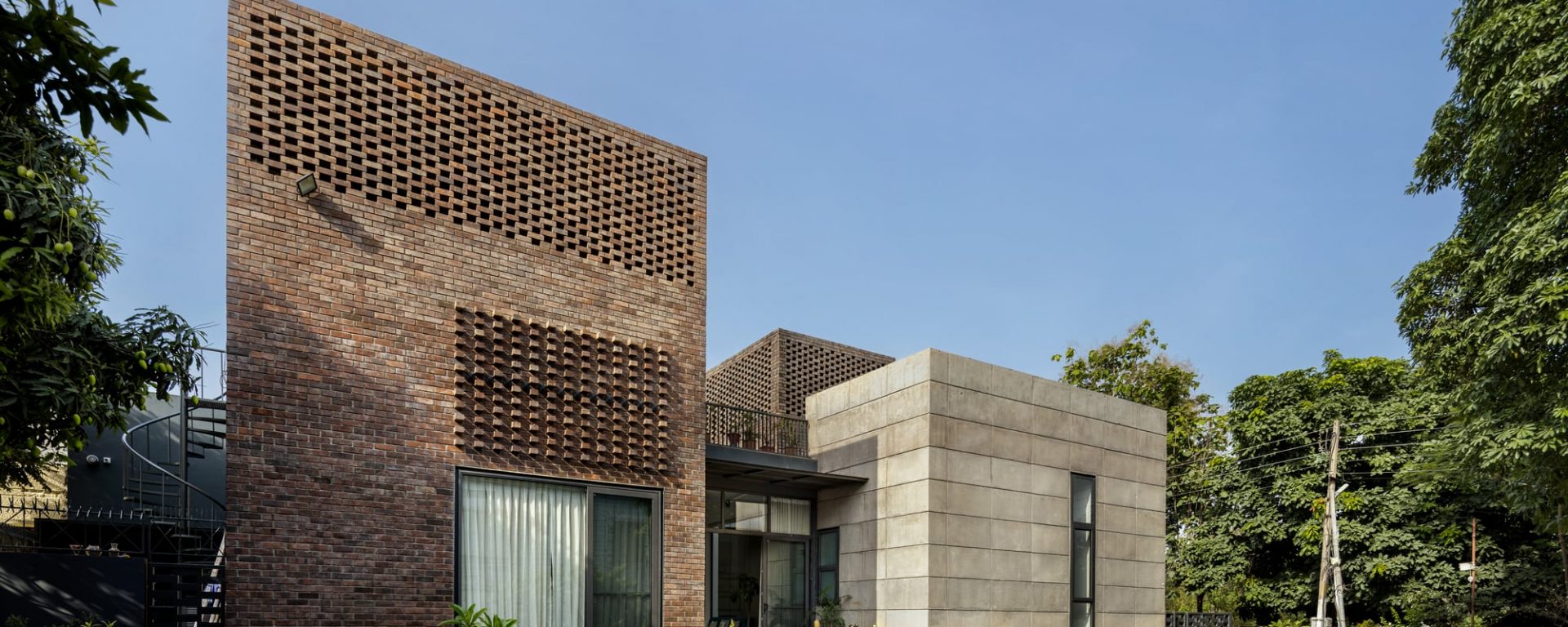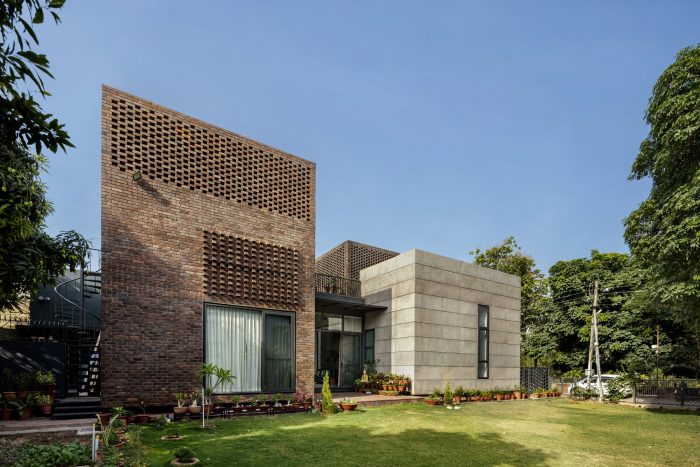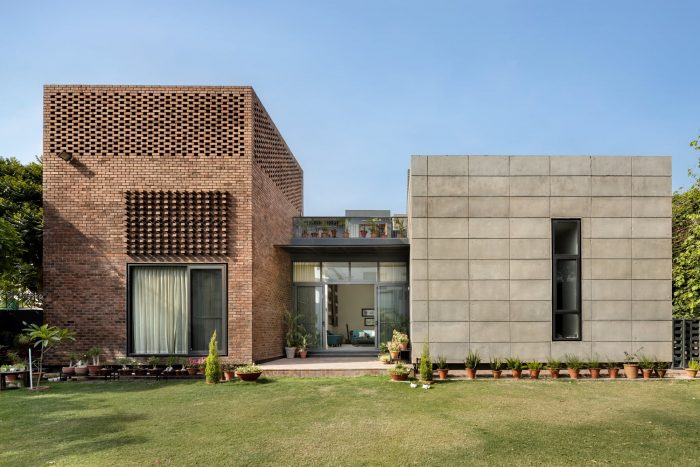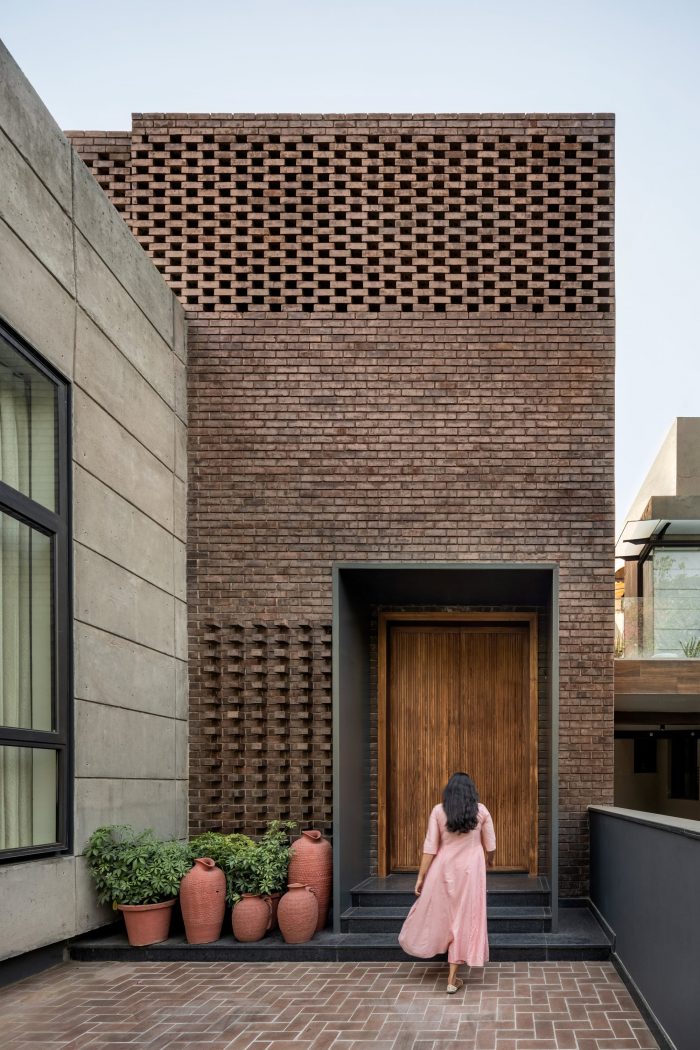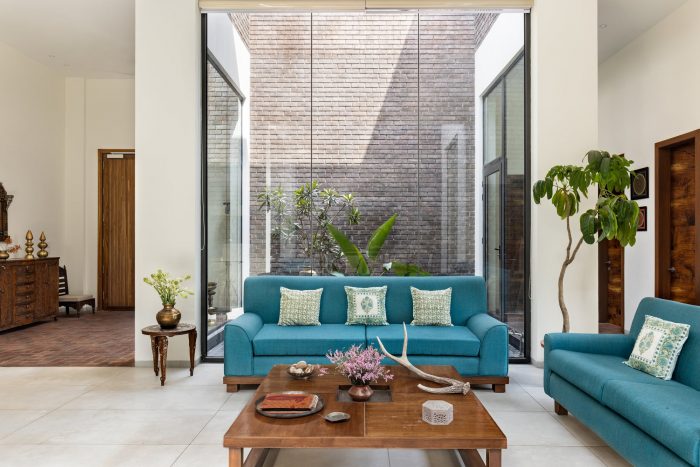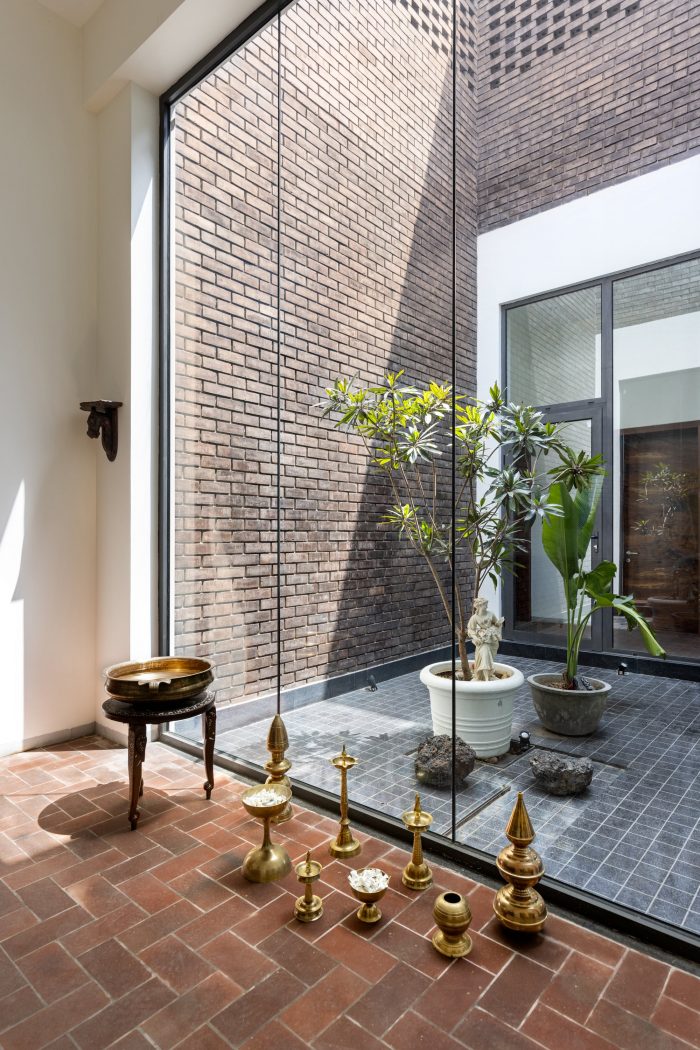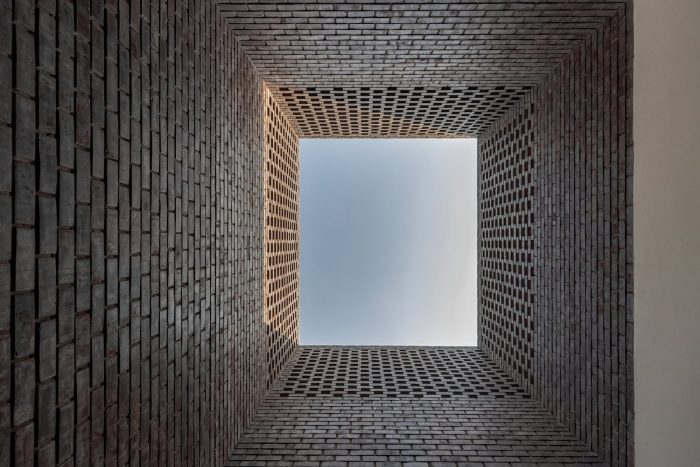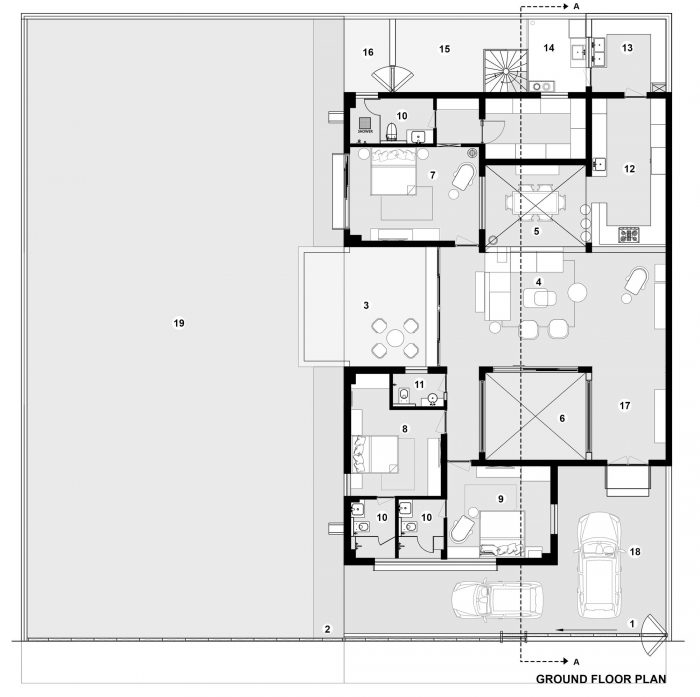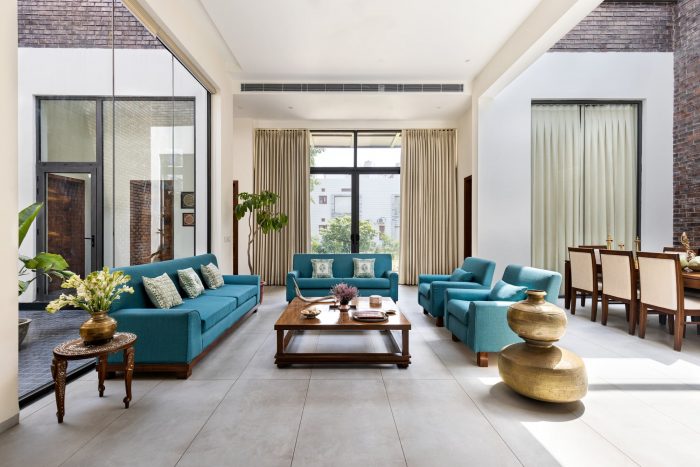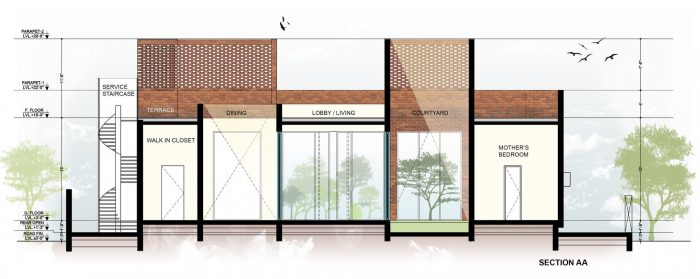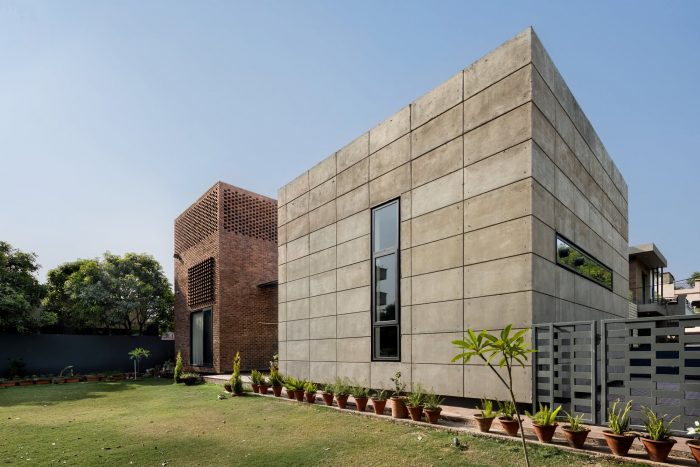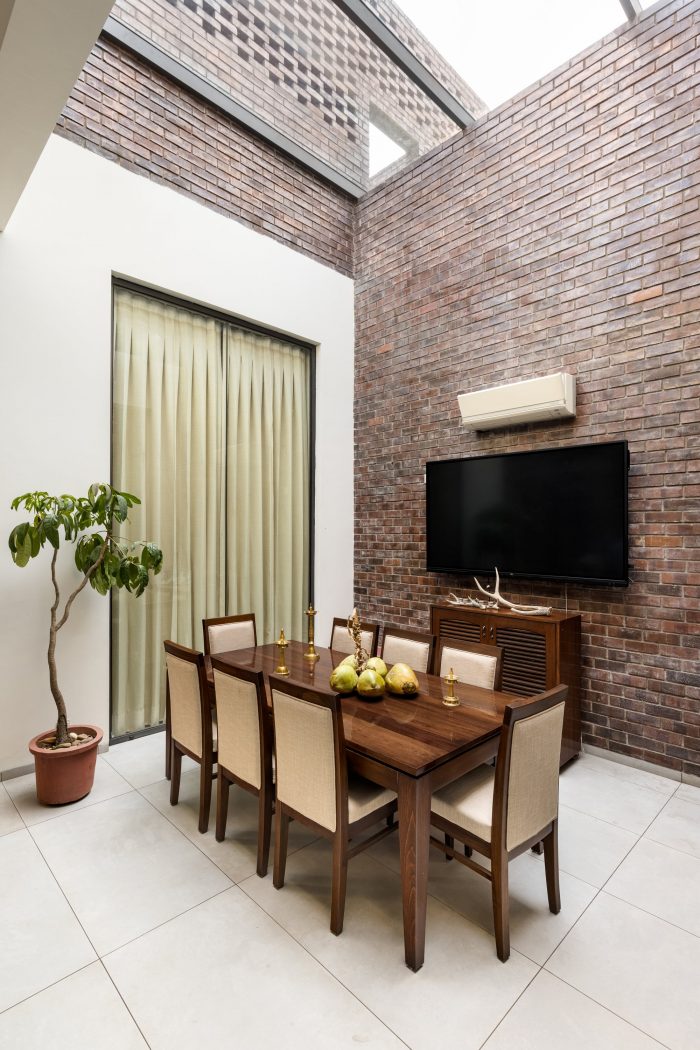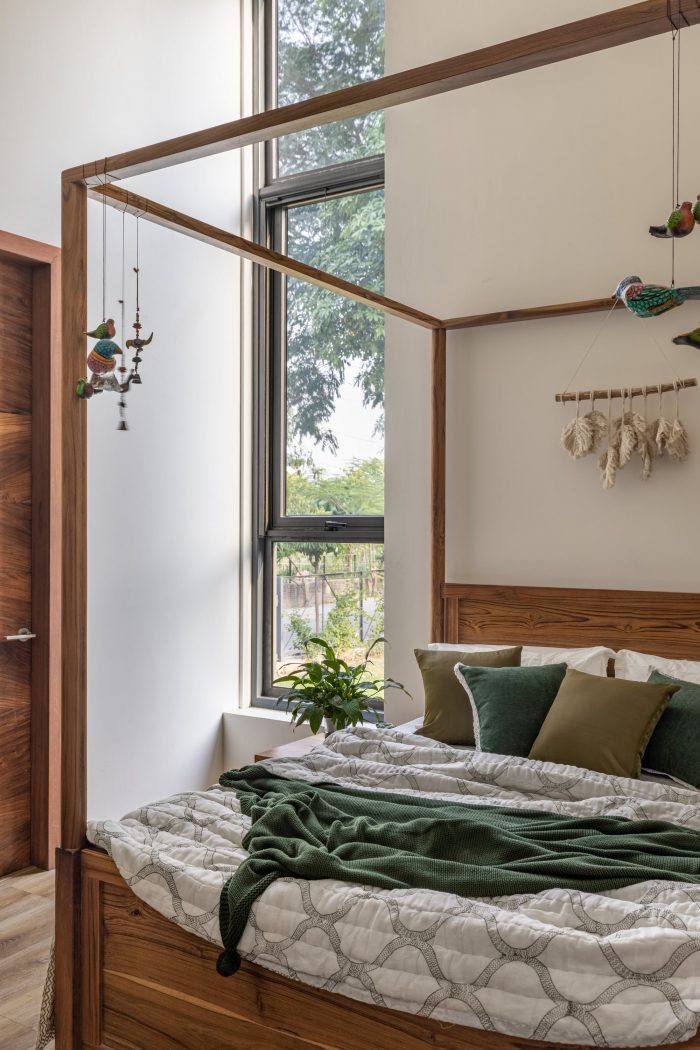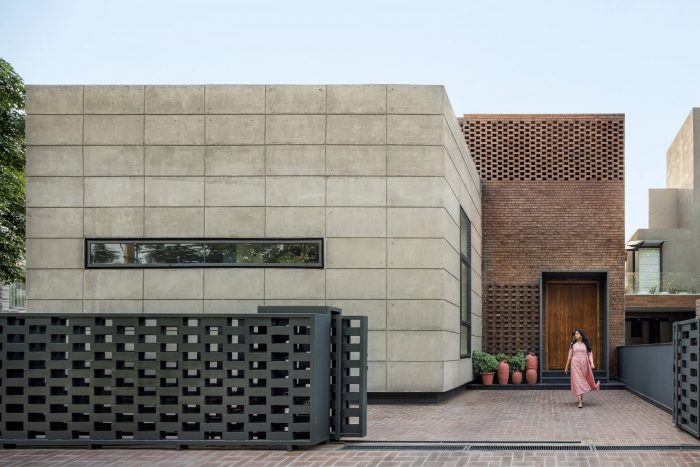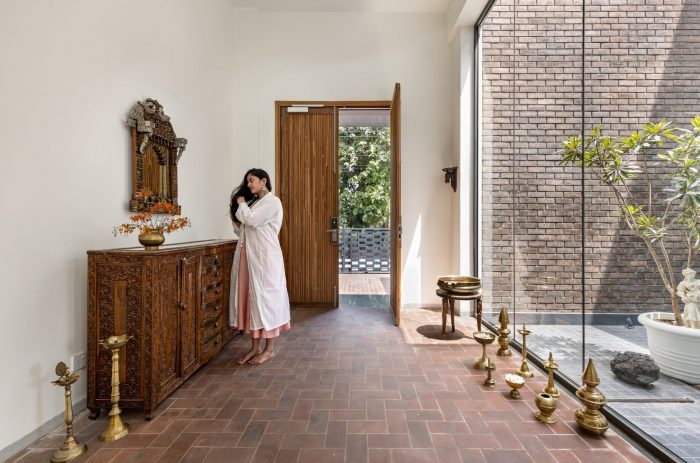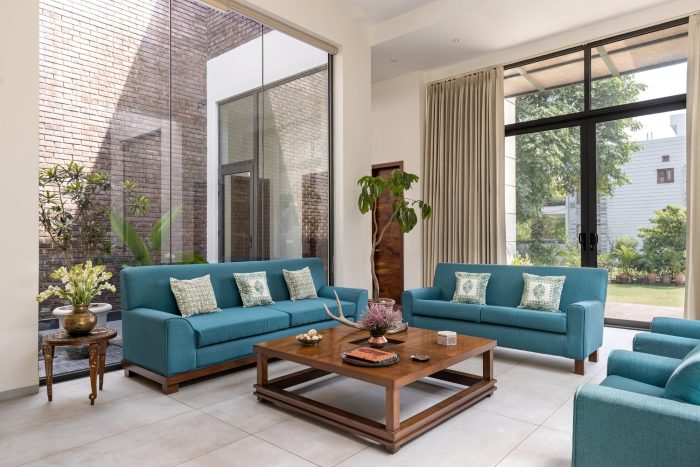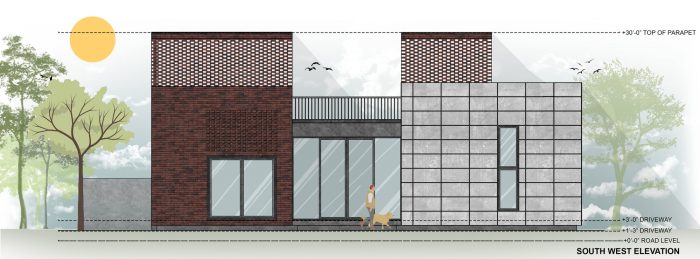砖房位于潘切库拉20区的一个普通住宅区,地块大小为42’X82’,正面可俯瞰道路对面的南面和东南面的森林公园,并与西南面的草坪共享边界,沿两个主要正面提供如画的自然景观。该家庭由一对50多岁的夫妇和他们的老母亲组成。他们希望有三间卧室,一个有独立烹饪区的体面的厨房,以及一个有客厅和餐厅的大型公共空间。当客户在重建他们的家时,他们清楚地知道,他们希望能够不受限制地进入草坪,这恰好是该地块的位置和方向的好处之一。他们想让草坪成为他们日常生活的一部分。
Located in a modest residential neighborhood of sector 20, Panchkula, the Brick House, with a plot size of 42’ X 82’, overlooks a woody park towards South and South-East across the road on the front, and shares its boundary with a lawn on the South-West, offering picturesque views of nature along two major frontages. The family consists of a couple in their fifties and their elderly mother. They wanted three bedrooms, a decent kitchen with a separate cooking area, and a large common space with living and dining. As the client was reconstructing their home, they were clear that they wanted to have unbound access to the lawn, which happens to be one of the perks of the site’s location and orientation. They wanted to make the lawn a part of their day-to-day routine.
空间–给我们的空间要求都可以在地面上得到满足;因此,在如何引入体量和诱导体量的相互作用以创造一个挑衅性的外观方面,这给我们带来了挑战。概念–根据设计要求和现场环境,我们的直观思考过程是让自然成为设计空间的指南,并让它渗透到建筑环境中,这也是最明显的。为了颂扬安藤的哲学:”我们从自然界借来空间,在此基础上进行建设”,我们试图在任何可能的地方引入绿色,在空间需要的地方在建筑中创造绿色,在我们无法做到的地方抓住其本质。
Space – The space requirements given to us could all be accommodated on ground level; therefore, it posed a challenge for us in terms of how to introduce massing and induce the interplay of volumes to create a provocative exterior. Concept – Owing to the brief and in response to the site context, the intuitive thought process which also felt like the most obvious one, was to let nature be the guide in designing the spaces and to let it penetrate the built environment. Paying an ode to Ando’s philosophy, “We borrow the space from nature upon which we build”, we tried to bring in green wherever we could, create green amidst built wherever the space demanded, and capture its essence where we could do neither.
故事–通过沿草坪的短距离穿越,走到房子的南面入口处,迎接我们的是一个宽大的阳台,它被推到了建筑的边缘,上面摆放着业主的妻子坚持要保留的花盆,还有一个秋千架,可以在上面享受晚间茶,呼吸大自然的绿色。阳台通向一个宽敞的生活空间,乍一看会让人怀疑他们是否在室内,因为它坐落在两个院子的怀抱中,让光线涌入。生活区被包裹在房子深处,远离草坪,以保护来自西南方的刺眼阳光。室内空间的构成被设想为一种尝试,使人居和自然融合在一起。居住空间是房子的中心,大多数能量都居住在这里,从南边的草坪中获得自然的宁静,从东边和西边的庭院中进入的阳光中获得活力。外面的绿色景观被真诚地捕捉到,并被放在最常去的空间旁边,这样它就成了室内生活的潜意识背景。
Story – Upon approaching the South entrance of the house through a short traverse along the lawn, one is greeted by a generous verandah which is pushed into the line of the building, decked up with flowery planter pots that the owner’s wife insisted on keeping, along with a swing set to enjoy evening teas on, breathing in the green of nature. The verandah leads to a voluminous living space that at first glimpse would make one wonder whether they are indoors or not since it sits cradled in the lap of two courtyards that let a gush of light in. The living area is cocooned deep into the house away from the lawn to be protected by the harsh sun from the southwest. The interior composition of the spaces was envisioned as an attempt at bringing about the convergence of habitat and nature. The living space is the center of the house where most energies reside, receives serenity of nature from the lawn on the south and vitality from sunlight that enters through courtyards on the east and west. The view of the green outside is sincerely captured and put conspicuously right beside the most frequented space so that it becomes the subconscious background to the life playing inside.
主卧和客卧沿南墙布置,俯瞰草坪,使用户感到与自然的持续联系。母亲的卧室面向东南墙,俯瞰马路对面的公园。起居室东面的庭院是一个绿色的庭院,三面都是玻璃,在视觉和物理上将卧室和起居室空间连接起来,并灌输了一种流动感。庭院深入客厅,以确保与之相邻的空间相互遮蔽。庭院在起居室的西边,它进一步通向厨房、调料厨房和朝后的服务区。空间的顺序是根据家庭活动的功能模式而确定的。服务区有一个次要的接入点,以避免家政服务的干扰。
The master and guest bedrooms have been placed along the South wall overlooking the lawn, making the user feel a constant connection with nature. The mother’s bedroom faces the South-East wall overlooking the park across the road. The courtyard on the east of the living is a green court lined with glass on three sides that visually and physically connects the bedrooms to the living space and instills a sense of fluidity. The courtyard sits deep into the living room to ensure mutual shading of the spaces adjoining it. The courtyard on the west of the living house’s dining which further leads up to the kitchen, spice kitchen, and a service area towards the rear. The sequencing of spaces was derived from the functional patterns of the household activities. A secondary access point has been given to the service zone to avoid disruption from house help.
设计–院子的认知汇合处通过引入光线来增强空间,这是所有生命的希望。它们上升到达到两层楼的高度,用着色的线切割砖砌成,其颜色和纹理给人一种被舒适的土壤所包围的内在感觉。院子的墙体总高度的大约四分之一是用砖块贾里排成的。院子的深度确保了只有反射光在中午时分进入,而jali在黎明和黄昏时分让散射光进入,因此,光线的节奏在一天中随着砖块的音乐曲调起舞,以达到一种平和的热舒适状态。
Design – The cognitive confluence of courtyards enhances the space by bringing in light, a hope for all life. They rise to attain double-story height, masoned with pigmented wire cut bricks, the color, and texture of which give an inherent feeling of being ensconced by the cozy soil. About a quarter of the total height of the courtyard’s wall is lined up with brick jali. The depth of the courtyard ensures that only reflected light enters during noon and jali lets in diffused light during dawn and twilight hours and so, the rhythm of light is made to dance along the tune of the brick’s music throughout the day to achieve a pacified state of thermal well-being.
室内—室内方案的色调保持低调,采用石材、胡桃木和砖头的颜色和纹理规格,这些都是来自于大地,在空气中灌输一种在大自然的确定性和安全性中的感觉。空间的构成方式保留了客户所喜欢的传统印度风格的家具。墙壁的温暖的白色成为一个完美的背景,衬托出业主的妻子制作的块状印刷挂毯和手绘草图。浅色的墙壁与灰色的地板和红砖相得益彰,院子里的植物为其注入了一抹完美的绿色。丰富的胡桃木门和金色的铜盆为这里增添了朴素的优雅。
Interior – The palette of the interior scheme was kept muted with specs of colors and textures of stone, walnut wood, and bricks, that are vicariously derived from the earth, to imbue in the air, a feeling of being amidst the certainty and security of nature. The spaces have been composed in a manner that retains the traditional Indian vibes of the furnishings that the client prepossessed. The warm white of the walls becomes a perfect backdrop to block printed tapestry and hand-drawn sketches made by the owner’s wife. The light walls compliment the gray flooring and red bricks, to which a perfectly balanced touch of green is infused by the plants that adorn the courtyard. The richness of walnut wood of doors and gold of brass pots add earthy elegance to the whole setup and transport you to faraway villages of India.
外观 – 场地周围的绿色景观使我们选择了一种颜色和质地的调色板,使建筑脱颖而出,但又不至于太过喧闹,从而削弱了宁静的环境。为了体现建筑围护结构与自然的互动关系,我们选择了两者共同的元素–“砖”,而为了巩固它,我们选择了 “混凝土”–以其原始的形式;砖的红色与自然的绿色形成对比,而灰色则是安抚剂。根据安藤的名言:”太阳不知道它有多大,直到它击中建筑物的侧面”,这两种材料在灯光下也会相互促进,相互影响。东南和西南的正面开辟了两个相邻的侧面,将成为旁观者可见的房屋的主要面孔。这给了我们一个工作的画布。
Exterior – The green landscape of the site surroundings leads us to choose a color and texture palette that would make the building stand out and yet, be not too loud as to subdue the peaceful setting. To manifest an interactive relationship of the built envelope with nature, an element common to both – ‘Brick’ was chosen, whereas to solidify it, ‘Concrete’ – in its raw form; brick red all the while being the contrast and gray being the pacifier, to nature’s green. In keeping with Ando’s quote, “The Sun never knew how great it was till it hit the side of a building”, the two materials also enhance each other with mutual grace when lit up. The frontage of south-east and south-west opened two adjacent sides that would become the dominant face of the house visible to onlookers. This gave us a canvas to work upon.
体积的交错来自于客厅的不同空间特征;庭院和阳台,共同形成了一个外墙,甚至让光线都不知道从哪里打过来,这样光线本身就可以突出,而不是建筑。印度传统建筑的优雅的监狱特征被编织在砖砌体中,这与混凝土的朴素和触觉性质相一致。面向东方的大门被一个明确的混凝土框架所强调,与棕色的胡桃木形成巧妙的对比。外墙有一个圆滑的窗户,加强了建筑的水平性,并且比眼睛的高度高出一尺,也照顾到了前面的隐私。从让人想起他们童年的家,让人想起裸露的砖块和anangan,到自豪地站在现代城市房屋中,它也保留了过去的文化特征。因此,砖屋真正让人有了归属感。
The volumetric staggering derived from diverse spatial characteristics of the living room; courtyards and verandah, cohesively conclude to form a facade that makes even the light wonder where to hit it from so that light itself may stand out rather than the building. The graceful jail feature of traditional Indian architecture is woven into the brick masonry which equipoises the plain and tactile nature of concrete. The main door facing east is accentuated by a defined concrete frame that subtly contrasts with the brown walnut wood. The facade is ribboned with a sleek window that enhances the horizontality of the building and being a shy foot above eye level, also takes care of privacy from the front. From reminding one of the homes of their childhood, reminiscent of exposed bricks and aangan to standing proudly amidst the modern city houses, it also preserves the cultural identity of the past. The Brick House thus, truly makes a person feel belonged.
Architects: Studio Ardete
Area : 239 m²
Year : 2021
Photographs :Purnesh Dev Nikhanj
Manufacturers : AutoDesk, Lumion, Grohe, Honeywell, Schüco, Toto, Diakin, FLOS, Spacewood, Trimble Navigation, Vetromoda, Yale, wooden doors with Turakhia Veneer , wooden doors with Turakhia Veneer
Lead Architects : Ar.Badrinath Kaleru and Ar.Prerna kaleru
Design Team : Sanchit Dhiman,Nisha Singh Sarao, Nancy Mittal, Abhimanyu Sharma,Satish Sinhmar
Clients : Mr.Rampal
Civil Contractor : Mr Rohan Bansal And Shailesh
Interior Stylist : Rahool Kukreja
City : Panchkula
Country : India

